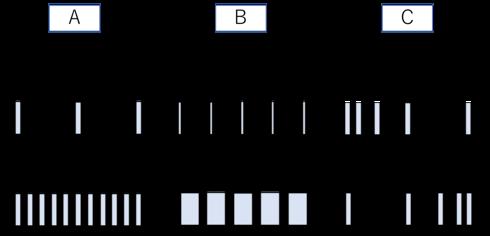Wristband device with four vibrating elements

"A Method to Manipulate Subjective Time by using Tactile Stimuli of Wearable Device" announced by the research team of Murao Laboratory, Ritsumeikan University This is a study that verified whether it is possible to manipulate the length of time that people feel physically) with tactile stimulation from a wrist-worn device such as a smartwatch. [Image] Stimulation patterns with different number of stimuli There is a psychological phenomenon in which a person's subjective time changes depending on external stimuli. Using this psychological phenomenon, we focused on a wrist-type device that can be worn at all times so that subjective time can be manipulated anytime and anywhere. The method of presentation was chosen to be tactile rather than the many existing visual and auditory methods. The tactile stimulation is given by vibration from the wrist to the skin. The prototype consists of four vibration elements for tactile stimulation, a wristband for wearing the vibration elements, a microcomputer board (Arduino), a notebook PC, and software for presenting stimulation. In the experiment, we evaluated how subjective time changes by manipulating tactile stimulation patterns. Subjects were 30 people in their early twenties and evaluated changes in subjective time for 10 seconds. For tactile stimulation, 3 types of 10-second stimulation patterns are available. The first event is a stimulation pattern with different number of stimulations. Specifically, the number of times of stimulation is 3 times, 5 times, and 11 times. The second type is stimulation patterns with different stimulation durations. The duration of stimulation is 5 times of 200 ms, 5 times of 500 ms, and 5 times of 1000 ms. The third type is stimulation patterns with different stimulation time intervals. Perform 5 times with widening time intervals between stimuli, 5 times with equal intervals, and 5 times with narrowing times. The procedure is to execute two tactile stimulation patterns and have them choose which one felt longer. Subjects experienced two types of stimuli and responded that the former was longer, the latter was longer, or both were the same. This trial was performed for 3 pairs of 2 out of 3 stimulus patterns. As a result of the experiment, subjective time lengthened when the number of stimuli was increased, and decreased when the number was decreased. This result was the opposite of the previous research using auditory stimulation, and the same tendency as the previous research using visual stimulation. Subjective time increased when the duration of stimulation was increased, and decreased when it was decreased. Even if the stimulation time was changed, the subjective time did not change with a certain tendency. In the next experiment, we evaluated how much tactile stimulation could change subjective time into the actual passage of time. Subjects were asked to experience 6 different stimulus patterns for 10 seconds each: 3 times and 11 times of stimulation, duration of stimulation of 200ms and 1000ms, time interval between stimulations widening and narrowing, and how many seconds they felt. I got an answer. As a result, the subjective time was 9.63 seconds after 3 stimulations, 3.7% shorter than the actual time. In contrast, 11 stimuli resulted in a subjective time of 16.7 seconds, 16.7% longer than the actual time. For other stimuli, the subjective time changed as shown in the table. From this result, it was found that the tactile stimulation to the wrist can make the subject feel shorter or longer than the actual time. This result can be applied not only to smartwatches, but also to wearable devices such as HMDs and earphones, and mobile devices such as smartphones using vibration elements. It can be used in a wide range of ways, such as shortening the boring time when you feel pain or extending the rest time of exercise. Source and image credits: Kiichi Shirai, Kyosuke Futami, Kazuya Murao. "Study of Subjective Time Control Method Using Tactile Stimulation." Research Report Ubiquitous Computing System (UBI) 2021.1 (2021): 1-9. http ://id.nii.ac.jp/1001/00211341/Kiichi Shirai, Kyosuke Futami, and Kazuya Murao. 2021. A Method to Manipulate Subjective Time by using Tactile Stimuli of Wearable Device. In 2021 International Symposium on Wearable Computers (ISWC) '21). Association for Computing Machinery, New York, NY, USA, 63-67. DOI: https://doi.org/10.1145/3460421.3480932 * Yamashita, who presides over the web media "Seamless" that introduces the latest research in technology. Written by Yuki. Mr. Yamashita picks up highly novel scientific papers and explains them.
ITmedia NEWS


